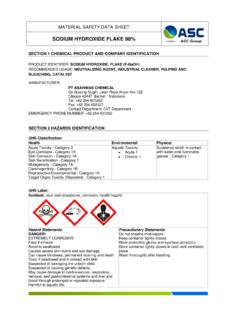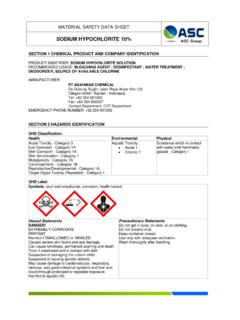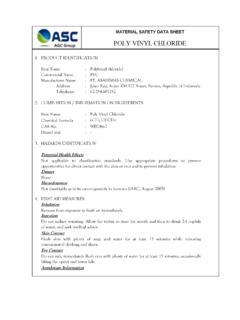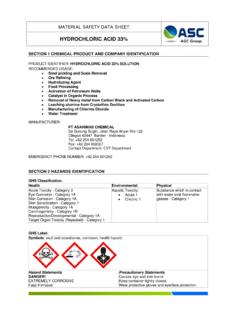Transcription of SODIUM HYDROXIDE LIQUID 48% - Asahimas …
1 MATERIAL SAFETY DATA SHEET SODIUM HYDROXIDE LIQUID 48% SECTION 1 CHEMICAL PRODUCT AND COMPANY IDENTIFICATION PRODUCT IDENTIFIER: SODIUM HYDROXIDE , LIQUID (L-NaOH) RECOMMENDED USAGE: Neutralizing agent, industrial cleaner, pulping and bleaching, catalyst MANUFACTURER: PT Asahimas CHEMICAL Ds Gunung Sugih, Jalan Raya Anyer Km-122 Cilegon 42447 Banten - Indonesia Tel: +62 254 601252 Fax: +62 254 602027 Contact Department: CVT Department EMERGENCY PHONE NUMBER: +62 254 601252 SECTION 2 HAZARDS IDENTIFICATION GHS Classification: Health Environmental Physical Acute Toxicity - Category 3 Eye Corrosion - Category 1A Skin Corrosion - Category 1A Skin Sensitization - Category 1 Mutagenicity - Category 1A Carcinogenicity - Category 1B Reproductive/Developmental - Category 1A Target Organ Toxicity (Repeated) - Category 1 Aquatic Toxicity: Acute 1 Chronic 1 Substance which in contact with water emit flammable gasses - Category 1 GHS Label: Symbols: skull and crossbones, corrosion, health hazard Hazard Statements DANGER!
2 EXTREMELY CORROSIVE Fatal if inhaled. Avoid to be swallowed. Causes severe skin burns and eye damage. Can cause blindness, permanent scarring and death. Toxic if swallowed and in contact with skin Suspected of damaging the unborn child. Suspected of causing genetic defects. May cause damage to cardiovascular, respiratory, nervous, and gastrointestinal systems and liver and blood through prolonged or repeated exposure. Harmful to aquatic life. Precautionary Statements Do not breathe mist/vapors. Keep container tightly closed. Wear protective gloves and eye/face protection. Store container tightly closed in cool/ well-ventilated place. Wash thoroughly after handling. MATERIAL SAFETY DATA SHEET SODIUM HYDROXIDE LIQUID 48% SECTION 3 COMPOSITION, INFORMATION ON INGREDIENTS CHEMICAL IDENTITY: SODIUM HYDROXIDE , LIQUID TRADE NAMES/SYNONYMS: CAUSTIC SODA; SODA LYE; LYE; LIQUID ; SODIUM HYDRATE; SODIUM HYDROXIDE (NaOH); LIQUID CAS NUMBER: 1310-73-2 EC NUMBER (EINECS): 215-185-5 EC INDEX NUMBER: 011-002-00-6 MINIMUM PERCENTAGE: 48% SECTION 4 FIRST AID MEASURES INHALATION: If adverse effects occur, remove to uncontaminated area.
3 Give artificial respiration if not breathing. If breathing is difficult, oxygen should be administered by qualified personnel. Get immediate medical attention. SKIN CONTACT: Wash skin with soap and water for at least 15 minutes while removing contaminated clothing and shoes. Get immediate medical attention. Thoroughly clean and dry contaminated clothing and shoes before reuse. Destroy contaminated shoes. EYE CONTACT: Immediately flush eyes with plenty of water for at least 15minutes. Then get immediate medical attention. INGESTION: If swallowed, drink plenty of water, do NOT induce vomiting. Get immediate medical attention. NOTE TO PHYSICIAN: For inhalation, consider oxygen. Avoid gastric lavage or emesis. SECTION 5 FIRE FIGHTING MEASURES SUITABLE EXTINGUISHING MEDIA: regular dry chemical, carbon dioxide, water, regular foam Large fires: Use regular foam or flood with fine water spray. FIRE AND EXPLOSION HAZARDS: Negligible fire hazard.
4 FIRE FIGHTING: Move container from fire area if it can be done without risk. Cool containers with water spray until well after the fire is out. Stay away from the ends of tanks. SECTION 6 ACCIDENTAL RELEASE MEASURES - PERSONAL PRECAUTIONS, PROTECTIVE EQUIPMENT & EMERGENCY PROCEDURES: - ENVIRONMENT PRECAUTION: SOIL RELEASE: Dig holding area such as lagoon, pond or pit for containment. Cover with plastic sheet or tarp to minimize spreading and protect from contact with water. WATER RELEASE: Neutralize. - METHODS & MATERIALS FOR CONTAINMENT & CLEANING UP Do not touch spilled material. Stop leak if possible without personal risk. Small spills: Absorb with sand or other non-combustible material. Collect spilled material in appropriate container for disposal. Small dry spills: Move containers away from spill to a safe area. MATERIAL SAFETY DATA SHEET SODIUM HYDROXIDE LIQUID 48% Large spills: Dike for later disposal.
5 Keep unnecessary people away, isolate hazard area and deny entry. Notify Local Emergency Planning Committee and State Emergency Response Commission for release greater than or equal to RQ ( SARA Section 304). SECTION 7 HANDLING AND STORAGE - PRECAUTIONS FOR SAFE HANDLING: Use smallest possible amounts in designated areas with adequate ventilation. Keep containers closed when not in use. Empty containers may contain hazardous residues. Transfer solids using tools or equipment, which are corrosion - resistant. Cautiously, transfer into sturdy containers made of compatible materials. Never return contaminated material to its original container. Considerable heat is generated when diluted with water. Proper handling procedures must be followed to prevent vigorous boiling, splattering or violent eruption of the diluted solution. Never add water to caustic. ALWAYS ADD CAUSTIC TO WATER and provide agitation.
6 When mixing with water, stir small amounts in slowly. Use cold water to prevent excessive heat generation. In general, keep solid SODIUM HYDROXIDE away from water. Post DO NOT USE WATER signs in area of use to prevent accidental contact - PRECAUTIONS FOR SAFE STORAGE (including any incompatibilities): Store in a cool, dry, well-ventilated area. This material absorbs water. Keep containers tightly closed when not in use and when empty. Protect from damage. Store away from incompatable materials such as strong acids, nitroaromatic, nitroparaffinnic or organohalogen compounds. Use corrosion-resistant structural materials and lighting and ventilation systems in the storage area. Containers made of nickel alloys are preferred. Steel containers are acceptable if temperatures are not elevated. Nickel is the preferred metal fro handling this product. Plastics or plastic-lined steel, or FRP tanks of derakane vinyl ester resin may be suitable.
7 If outdoor storage of pearl caustic is unavailable, the pallets should be protected against extremes of weather. Do not expose sealed containers to temperatures above 40 C (104 F) SECTION 8 EXPOSURE CONTROLS, PERSONAL PROTECTION - CONTROL PARAMETERS: OCCUPATIONAL EXPOSURE LIMIT or BIOLOGICAL LIMIT VALUE: 2 mg/m3 OSHA TWA 2 mg/m3 OSHA ceiling (vacated by 58 FR 35338, June 30, 1993) 2 mg/m3 ACGIH ceiling 2 mg/m3 NIOSH recommended ceiling 2 mg/m3 UK OES STEL MEASUREMENT METHOD: Particulate filter; Hydrochloric acid; Titrate; NIOSHIV # 7401, Alkaline Dusts - APPROPRIATE ENGINEERING CONTROLS: Local exhaust ventilation should be applied wherever there is an incidence of point source emissions or dispersion of regulated contaminants in the work area. Ventilation control of the contaminant as close to its point of generation is both the most economical and safest method to minimize personnel exposure to airborne contaminants.
8 The most effective measures are the total enclosure of processes and the mechanization of handling procedures to prevent all personal contact. VENTILATION: Ensure compliance with applicable exposure limits. MATERIAL SAFETY DATA SHEET SODIUM HYDROXIDE LIQUID 48% PERSONAL PROTECTIVE EQIPMENT Maintain eye wash fountain and quick-drench facilities in work area. Detailed requirements for personal protective equipment should be established on a site-specific basis. EYE PROTECTION: Wear full face-shield and chemical safety goggles when there is potential for contact. Skin Protection: Wear appropriate personal protective clothing to prevent skin contact. Chemical protective clothing composed of natural rubber, neoprene, nitrile, or styrene/butadiene (SBR)-coated fabric is highly recommended, having break through times greater than one hour. Butyl rubber, polyethylene, chlorinated polyurethane, or polyvinyl alcohol may be used but data suggests breakthrough times of approximately an hour or more.
9 RESPIRATORY PROTECTION: Up To 10 mg/m3: Supplied Air Respirator (SAR) operated in a continuous-flow mode, eye protection needed; or full-facepiece respirator with high-efficiency particulate filter(s); or powered air-purifying respirator with dust and mist filter(s), eye protection needed; or full-facepiece Self-Contained Breathing Apparatus (SCBA); or full-facepiece SAR. Emergency or Planned Entry into Unknown Concentrations or IDLH Conditions: Positive pressure, full-facepiece SAR; or positive pressure, full-facepiece SAR with an auxiliary positive pressure SAR. ESCAPE: Full-facepiece respirator with high-efficiency particulate filter(s); or escape-type SCBA SECTION 9 PHYSICAL AND CHEMICAL PROPERTIES APPEARANCE PHYSICAL STATE: LIQUID COLOR: Colorless CHANGE IN APPEARANCE: hygroscopic ODOR: odorless ODOR THRESHOLD: Not available MOLECULAR FORMULA: Na-O-H MOLECULAR WEIGHT: PH: 14 (5% solution) MELTING POINT: 604 F (318 C) BOILING POINT: 2534 F (1390 C) FLASH POINT: Not available EVAPORATION RATE: Not applicable FLAMMABILITY: Not available VAPOR PRESSURE: 100 mmHg @ 1111 C VAPOR DENSITY: Not applicable RELATIVE GRAVITY (water=1): SOLUBILITY IN WATER: VERY soluble (111 g/100 mL at 20 C(68 F)) SOLVENT SOLUBILITY: Soluble: alcohol, glycerol Insoluble: acetone, ether MATERIAL SAFETY DATA SHEET SODIUM HYDROXIDE LIQUID 48% PARTITION COEFICIENT n-octanol / water: Not available AUTO-IGNITION TEMPERATURE: Not available DECOMPOSITION TEMPERTURE: Not available SECTION 10 STABILITY AND REACTIVITY - CHEMICAL STABILITY.
10 Stable at room temperature. Rapidly absorbs carbon dioxide from the air, forming SODIUM carbonate. Slowly absorbs moisture from the air - POSSIBILITY OF HAZARDOUS REACTIONS: REACTIVITY: May react with evolution of heat on contact with water. - CONDITIONS TO AVOID: Water, moisture, and air. Dangerous gases may accumulate in confined spaces. May ignite or explode on contact with combustible materials. - INCOMPATIBILITIES: combustible materials, acids, halo carbons, metals, halogens, oxidizing materials, peroxides, metal salts - HAZARDOUS DECOMPOSITION PRODUCTS: Thermal decomposition ; SODIUM OXIDE POLYMERIZATION: Will not polymerize. However, it can induce hazardous polymerization of acetaldehyde, acrolein, and acrylonitrile. SECTION 11 TOXICOLOGICAL INFORMATION IRRITATION DATA: 1 percent/24 hour(s) eyes-monkey severe; 500 mg/24 hour(s) skin-rabbit severe; 400 ug eyes-rabbit mild; 1 percent eyes-rabbit severe; 50 ug/24hour(s) eyes-rabbit severe; 1 mg/24 hour(s) eyes-rabbit severe; 1 mg/30second(s) rinsed eyes-rabbit severe TOXICITY DATA: 1350 mg/kg skin-rabbit LD50; 104-340 mg/kg oral-rat LD50; 40 mg/kg intra peritoneal-mouse LD50; 500 mg/kg oral-rabbit LDLo LOCAL EFFECTS: Corrosive: inhalation, skin, eye, ingestion ACUTE TOXICITY LEVEL: Toxic: ingestion Moderately Toxic: dermal absorption MEDICAL CONDITIONS AGGRAVATED BY EXPOSURE: eye disorders, skin disorders andallergies MUTAGENIC DATA: cytogenetic analysis - grasshopper parenteral 20 mg; cytogenetic analysis hamster lung 10 mmol/L.




